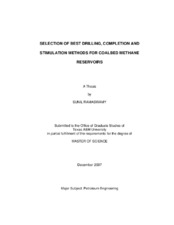| dc.description.abstract | Over the past three decades, coalbed methane (CBM) has moved from a mining
hazard and novel unconventional resource to an important fossil fuel that
accounts for approximately 10% of the U.S. natural gas production and reserves.
The expansion of this industry required development of different drilling,
completion and stimulation practices for CBM in specific North American basins,
owing to the complex combinations of geologic settings and reservoir parameters
encountered. These challenges led to many technology advances and to
development of CBM drilling, completion and stimulation technology for specific
geologic settings.
The objectives of this study were to (1) determine which geologic parameters
affect CBM drilling, completion and stimulation decisions, (2) identify to the
engineering best practices for specific geologic settings, and (3) present these findings in decision charts or advisory systems that could be applied by industry
professionals.
To determine best drilling, completion and stimulation practices for CBM
reservoirs, I reviewed literature and solicited opinions of industry experts through
responses to a questionnaire. I identified thirteen geologic parameters (and their
ranges of values) that are assessed when selecting CBM drilling, completion and
stimulating applications. These are coal thickness, number of seams, areal
extent, dip, depth, rank, gas content, formation pressure, permeability, water
saturation, and compressive strength, as well as the vertical distribution of coal
beds and distance from coal reservoirs to fracture barriers or aquifers. Next, I
identified the optimum CBM drilling, completion and stimulating practices for
specific combinations of these geologic parameters. The engineering best
practices identified in this project may be applied to new or existing fields, to
optimize gas reserves and project economics.
I identified the best engineering practices for the different CBM basins in N.A and
combined these results in the form of two decision charts that engineers may use
to select best drilling and completion practices, as well as the optimal stimulation
methods and fluids for specific geologic settings. The decision charts are
presented in a Visual Basic Application software program to facilitate their use by
engineers. | en |


